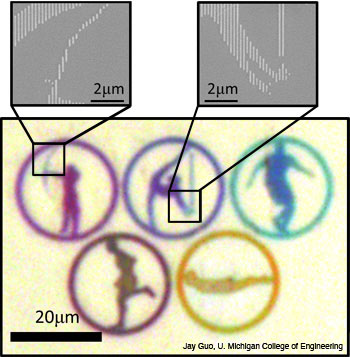
These rings (20 µm across) have color created by the width of the slits (see black and white inset). For example, yellow is produced with slits that are each 90 nm wide. The technique uses light funneling to catch and trap particular wavelengths.
Researchers at the University of Michigan (U.S.A.) have found a way to lock in structural color using sub-wavelength structures (Scientific Reports 3, 1194). If the technique can be developed further, it could be used with e-readers and other reflective displays, as well as for sensors and hyperspectral imagers.
Diffraction gratings provide structural color, but the predominant color changes with viewing angle. Instead of using gratings on the order of the wavelengths, and on the surface of the material, the researchers went vertical. Group leader Jay Guo explains, "Light is funneled into the nanocavity, whose width is much, much smaller than the wavelength of the light." Surprisingly the longer wavelengths of light get trapped in narrower grooves.
To demonstrate their device, the researchers etched nanoscale grooves in glass and coated the grooved glass plate with a thin layer of silver. When light hits the grooved surface, the transverse electric component creates a polarization charge at the metal slit surface, boosting the local electric field near the slit, which preferentially pulls in the transverse magnetic component of a particular wavelength of light.
The demonstrated optical device has high absorption, as large as 96 percent in the visible spectrum, with colors that don’t change over a +/- 80 degree viewing angle. The device also demonstrated wide color tunability throughout the entire visible spectrum and pixel sizes smaller than the diffraction limit.
Right now, the new device can make static pictures. Even static displays, however, can be attractive with bright sunlight-visible color in low-energy-consumption reflective displays.
